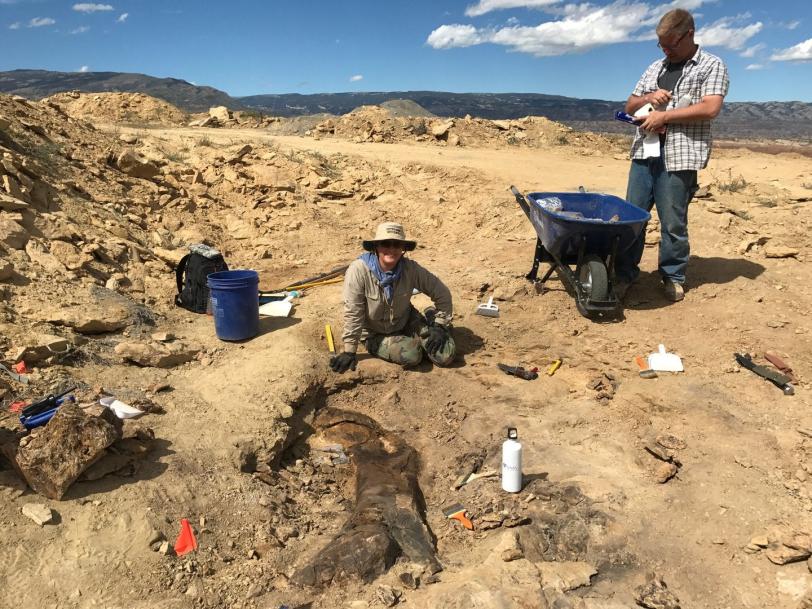A mile-long graveyard of Jurassic fossils sparks a new international science collaboration
Researchers will use SLAC’s X-ray light source to probe 150-million-year-old dinosaur fossils at the atomic level.
The Children’s Museum of Indianapolis announced plans this week for Mission Jurassic, a project that will support paleontological excavation of a fossil-rich plot of land in northern Wyoming. The project will bring together scientists from around the world, including the Department of Energy’s SLAC National Accelerator Laboratory, to reveal dramatic new secrets about the world of millions of years ago.
“Mission Jurassic is a wonderful project because it's not just an isolated fossil – it's a suite of different organisms, including dinosaurs and plants, in a single location,” says SLAC scientist Nick Edwards. “We hope that through our involvement in this project, we will contribute some new information to the preservation, chemistry and maybe even the basic understanding of these extinct organisms, ancient ecosystems, and Earth history on the broader scale.”
The Children’s Museum will serve as the Mission Jurassic leader. The project is made possible through a lead gift from Lilly Endowment Inc. Spearheaded by Phil Manning and Victoria Egerton of the University of Manchester in England, both scientists-in-residence at The Children’s Museum, more than 100 scientists from three countries will join forces to investigate the rare confluence of Jurassic Period fossils, trackways and fossilized plants. The site will provide clues that promise to tell a more complete story about the Jurassic Period.
“We have been using SLAC’s Stanford Synchrotron Radiation Lightsource (SSRL) for over a decade to help map the subtle changes in chemistry that are a function of burial environments,” Manning says. “This work has real-world impact on how we might plan the long-term burial and disposal of waste in the 21st Century. We use the fossil record as a ‘hindsight laboratory’ that can better inform science on the mass transfer of compounds from the biosphere into the lithosphere”.
The Jurassic Mile
Project leaders are calling the fossil-rich, mile-square plot of land the Jurassic Mile. There are four main quarries within the multi-level, 640-acre site that offer a diverse assemblage of Morrison Formation articulated and semi-articulated dinosaurs. It has also yielded associated animals, fossil plants and dinosaur trackways of the Late Jurassic Period, 150 million years ago.
Nearly 600 specimens weighing more than six tons have been collected from this site over the past two years, despite the fact that only a fraction of the site has been explored. They include the bones of an 80-foot-long sauropod (Brachiosaur) and 90-foot-long Diplodocid. A 6-foot-6-inch sauropod scapula (shoulder bone) and several blocks containing articulated bones are among the material collected during the 2018 field season. A 5-foot-1-inch femur was revealed at the announcement on March 25, 2019.
Probing our world at the atomic level
SLAC, a key partner working with the University of Manchester team, will shine bright X-rays onto the fossils at the SSRL, a DOE Office of Science user facility that produces X-ray beams perfectly tailored for probing the world at the atomic and molecular level. New imaging techniques being developed by the team have already resulted in multiple high-impact scientific publications.
“Our primary instrument at SSRL is unique because it can do elemental imaging, which tells us where the elements are in fossils, and it can also do absorption spectroscopy, which tells us what chemical state they're in,” says Uwe Bergmann, a distinguished staff scientist at SLAC. “It allows us to detect a wide range of important biological and geochemical elements, from light elements like phosphorous and sulfur all the way to the transition metals.”
Specimens from the well-preserved fossil remains at the Jurassic Mile site will form the basis for a major expansion of The Children’s Museum of Indianapolis’ permanent Dinosphere exhibit that will add creatures from the Jurassic Period. The project is already utilizing cutting-edge science, from particle accelerators to some of the most powerful computers on the planet, to help resurrect the Jurassic dinosaurs and add momentum to the process of unearthing the lost world and forgotten lives.
This article is based on a press release from The Children's Museum of Indianapolis.
Contact
For questions or comments, contact the SLAC Office of Communications at communications@slac.stanford.edu.
SLAC is a multi-program laboratory exploring frontier questions in photon science, astrophysics, particle physics and accelerator research. Located in Menlo Park, Calif., SLAC is operated by Stanford University for the U.S. Department of Energy's Office of Science.
SLAC National Accelerator Laboratory is supported by the Office of Science of the U.S. Department of Energy. The Office of Science is the single largest supporter of basic research in the physical sciences in the United States, and is working to address some of the most pressing challenges of our time. For more information, please visit science.energy.gov.





